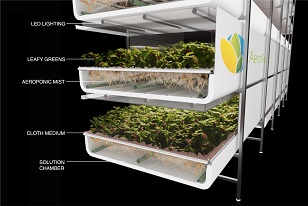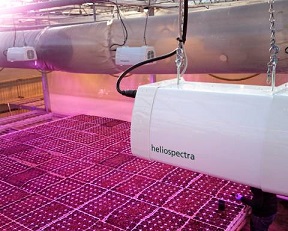Vertical farming is making headway into modern cities. Fresh produce being a unique selling point for vegetables, we will see more production units coming close to the customer. Vertical production units to be sure, often in old buildings and LED lighted, as space in cities is limited. Several concepts are in development, we expect them to make a breakthrough soon. Urban precision agriculture.

Vertical farming taking off
Last June, the Association for Vertical Farming held a ‘summit’ in Amsterdam. As it says on its website: ‘vertical farming has the potential to make this planet a healthier place and simultaneously contribute to a stronger economy.’ It lists ten advantages of vertical farming, among which limited agricultural runoff, year round crop production, up to 98% less water consumption compared to open field agriculture, and consistent, fresh and local produce. ‘However,’ it continues, ‘overcoming the many challenges the industry faces and repairing the planet’s ecosystems requires a departure from the status quo.’ One of those challenges, we presume, is the inertia of well-established relations in food industry and distribution, that have to be overcome by the newcomer.
But these obstacles do not prevent many start-ups and even incumbent companies to develop equipment and growing systems for this new form of urban agriculture. Among these is Philips, a relatively late entrant into the field of LED lighting for vertical agriculture, but making headway by organising under the name of BrightBox a large community of R&D groups and start-ups that use their lamps. This aims to be an open innovation research centre offering infrastructure for applied research. It rents out vertical farming ‘cells’ comprised of shelving units, LEDs and climate controls, with a growing surface area of up to 192 m2. For additional fees, BrightBox works with customers to develop ‘growth recipes’, that detail growth substrate, light spectra, light intensity, CO2 content, nutrient dosage, temperature, humidity, and light distance. And that analyse the result on much sought-after qualities like vitamin and nutrient content, longer shelf life, or enhanced flavours.

Some major projects
Among Philips’ many competitors are Heliospectra, an American company that has been active in LED-lit greenhouses for quite some time; and AeroFarms, a company that is ‘transforming agriculture’, as they put it. ‘We grow delicious, nutritious leafy greens and herbs without sunlight, soil, or pesticides. Our crops get the perfect amount of moisture and nutrients misted directly onto their roots in a completely controlled environment.’ AeroFarms is constructing the ‘world’s largest vertical farm’ in Newark, New Jersey, in an abandoned steel mill. It has secured $ 30 million funding from many sides, including Goldman Sachs and the New Jersey Economic Development Authority. For the latter, what counts is that AeroFarms projects to create many new jobs in this run-down quarter of Newark. The scheme is built upon the conviction that productivity gains will offset the high costs of the expensive technology.
Another company thinking big is Plantagon, a Swedish company that develops a skyscraper-like greenhouse for growing vegetables. Primarily lit by the sun instead of LED lamps. Plantagon aspires to combine three major areas of the economy: agriculture, technology and architecture, calling it agritechture. The company says that it ‘moves food and food production into the city (…) using existing assets and real estate with lower need for capital investments.’ The company aims to use excess heat, biomass and even CO2 emissions into assets for local food production. ‘Plantagon’s solutions are not entirely industrial in a traditional sense. We combine industrialized urban farming with real estate development, and create aesthetical projects for the urban environment.’ One of its main projects is the construction of a building partly dedicated to vertical farming in Linköping, Sweden.
But the future might well be in the medium scale
Reflecting on the future of these projects, we foresee no staple products like rice and wheat to be produced in this way; vertical farming will not solve the world food problem. But just growing vegetables of excellent quality might serve the urban consumer very well, and be profitable. We doubt however that the adequate scale is that of hectares. In order to profit from the freshness of such produce, this should be able to arrive on the plate of the customer within a few hours. The launching customers might well be restaurants, making sure that they can always serve the freshest vegetables of the highest quality possible. Supermarkets, or a group of supermarkets in a neighbourhood, might be the next customers. We foresee vegetable warehouses, serving maybe up to 10,000 or 20,000 consumers, in vacant offices or on urban wasteland. Packaging and transport of products will be a lot simpler, and the producer will always guarantee fresh quality. With proper sensor technology and automation, supermarket managers can deliver fresh vegetables as accurate as within just a few hours. From their computers they can check the availability of fresh lettuce, tomatoes, mushrooms, strawberries or any other vegetable or fruit from the next door vegetable growing ‘office’. The relatively limited scale of these vertical farming operations allows for transparent control. There is no need to apply large scale production facilities to reach acceptable business economics, as modern consumers are pleased to see the greenhouses around the corner and understand the benefits of less transportation; supported by excellent freshness and taste.
But there is a moot question on my mind. I posed it to Louise Vet, professor in plant ecology at Wageningen UR, as I interviewed her last month. As we start to know much more about soil life and its importance for plant health, I asked, are we going to lack anything vital if we turn to consuming vegetables grown on sterile substrates? The question has been on my mind, too, she answered. And I don’t know the answer.

Thanks for sharing useful information with us, We Grow Vertically. Vertical turmeric farming is the Next Generation Urban farming project lead by AS Agri & Aqua.
Thanks for sharing useful information with us, We Grow Vertically. Vertical turmeric farming is the Next Generation Urban farming project lead by AS Agri & Aqua. For more information visit http://www.asagriaqua.com/